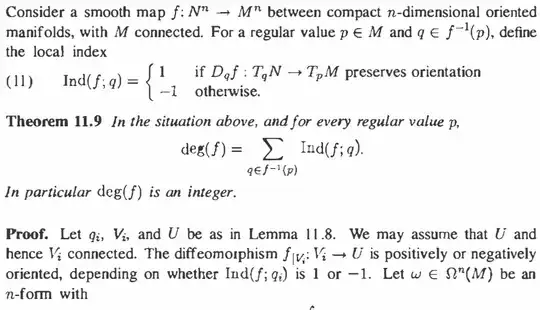My book is From Calculus to Cohomology by Ib Madsen and Jørgen Tornehave.
This is the definition of local index, Theorem 11.9 and the beginning of the proof of Theorem 11.9, which refers to Lemma 11.8.
In the beginning of the proof, I think it is claimed that $f|_{V_{q_i}}$ is positively oriented if and only if $D_qf$ is orientation-preserving.
Do I understand right?
If not, then what is meant? If so, then is the following proof correct?
2.1 In the first place, $(V_{q_i},f_{V_{q_i}})$ is a coordinate chart about $q_i$ in $N$, by Proposition 6.11 in An Introduction to Manifolds by Loring W. Tu, and therefore it makes sense to talk about whether or not $f|_{V_{q_i}}$ is positively oriented since I guess "positively oriented" is for coordinate maps and not arbitrary diffeomorphisms of manifolds...unless "positively oriented" actually means orientation-preserving, so the use of the adjective "positively oriented" for charts actually comes from the use of "positively oriented" for arbitrary diffeomorphisms of manifolds.
- Update: It's not a chart, as pointed out in answer. I forgot that I had actually realized that earlier.
2.2 $f|_{V_{q_i}}$ is positively oriented if and only if $D_q(f|_{V_{q_i}})$ is orientation-preserving.
2.3 $D_q(f|_{V_{q_i}})$ and $D_q(f)$ are identical by chain rule and by the fact that differential of inclusion from an open subset is still inclusion
2.3 Therefore, by (2.2) and (2.3), $f|_{V_{q_i}}$ is positively oriented if and only if $D_qf$ is orientation-preserving.
2.4 Remark: I think we don't assume connectedness here.
Do we have that $f|_{V_{q_i}}$ is negatively oriented if and only if $D_qf$ is orientation-reversing even if $U$ isn't connected?
Some context:
